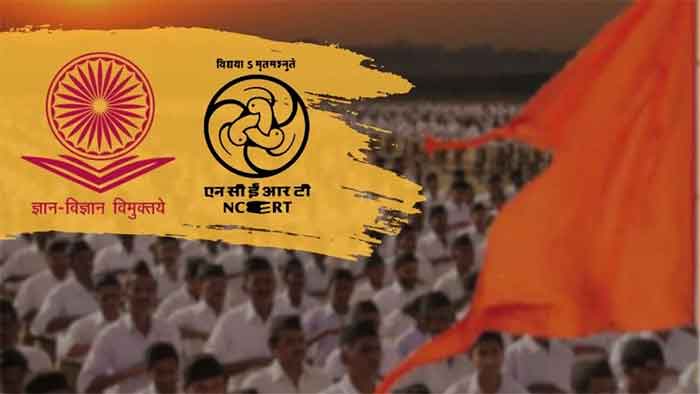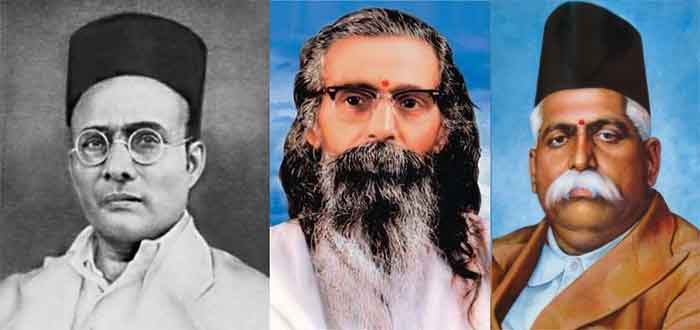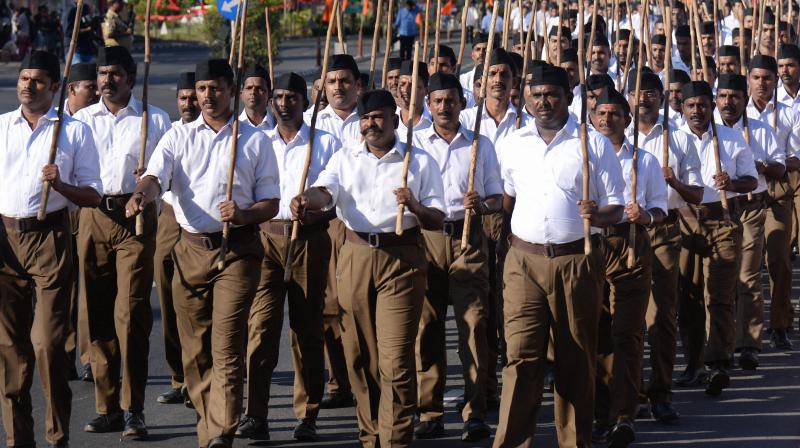
You can smell it at a distance, in the burnt out, blackened frames of torched homes and vehicles from yet another communal pogrom. You can see it in the blood stained corner of a railway platform, still fresh from a recent lynching. And you can hear it in the guttural cries of the frenzied, saffron swathed mobs, pledging murder all the way to their cherished goals.
Welcome, to the sights and sounds of Hindu Rashtra, that fantasy land of upper caste Hindus or savarnas masquerading as Indian ‘nationalists’, where they will rule unchallenged and forever. A frightening future, which they promise will be a recreation of Ram Rajya, a mythical time from ancient India, where the Lord Himself ensured everyone ‘knew their place’.
Their vehicle of choice to get there is a cowardly kind of ‘Hit and Run Hinduism’ – opportunist, state-sanctioned attacks on isolated individuals, weaker communities, the poor – all packaged with a huge dose of doublespeak and meant to frighten everyone else into submission and acquiescence.
If you are a Dalit, Adivasi, Muslim or any religious minority in India today, the signs of the Hindu Rashtra juggernaut are unmistakable. The wheels of this vehicle run directly over their flesh and bones, grinding them into dust.
When I say upper caste Hindus, let me be even more specific. While savarnas from across the country are involved, the ones most passionately behind this campaign for a Hindu Rashtra have been from the Gangetic plains and the so-called ‘cow belt’.
As I write this, I recollect a casual remark made nearly four decades ago, by a classmate of mine in the small central Indian town I was brought up in. It is still deeply etched there after all these years for some reason.
Pointing to the lady sweeping the courtyard of his house, when I went to visit him one day, this is what he said, “These low caste people have become quite uppity these days. Earlier they used to come, sweep and go away quietly, but now they have become bold enough to ask for wages!”
In the upper caste milieu, I lived in those days, my classmate’s statement was not very unusual at all, of course. It however succinctly captures the weltanschauungof the savarna castes. Endless subsidies for them at the cost of everyone else. This is exactly what their Hindu Rashtra is all about – running a sanctified, glorified kleptocracy.
In this part of India, the upper caste Hindu’s sense of being some kind of a ‘master race’ is all pervasive, usually displayed through verbal and physical abuse of people deemed ‘inferior’ or weaker to them. In my town, the Brahmins, Kshatriyas and even the normally less aggressive Baniyas – were always eager to show everyone around who was the real ‘boss’.
Community names like ‘chamar’ and ‘bhangi’ were used routinely as swear words, the Muslim was always the ‘katua’, all South Indians were ‘Madrasis’ and Bengalis mostly ‘refugees’. Languages, other than Hindi, were to be made fun of – including the lingua of the local rural folk – Bundelkhandi.
All dark-skinned people were of course relatives of the ‘demon’ Ravan himself, while the Adivasis were not considered human at all, just another type of goat or sheep to be cooked and consumed. (Funnily enough, they admired the white man immensely but abused him too as he refused to accept them as one of their own!)
Condense all this bigotry into one unified ideology and worldview – you will get exactly what the RSS and its various fronts – from the Bajrang Dal to the Durga Vahini really represent. In their cow-belt vision of ‘Hindu, Hindi, Hooliganistan’, only they – the ‘twice born’ speakers of the Deva Bhasha – will be the masters, while the rest will remain subordinates eternally.
Can Indians who don’t agree with all this do something about it? What would resistance even begin to look like? Can they continue to ignore the ongoing wanton murder and injury of Muslims in the country, the assault on Dalits and the emasculation of every democratic space by these pseudo-religious nationalists?
First of all it is essential to understand that none of what is happening in India today is not new in modern history, not even within South Asia itself. The quest for capturing the Indian modern state apparatus under the cover of religion closely mirrors similar attempts in the past by the Punjabi elite in undivided Pakistan and the Sinhala Buddhist chauvinists in Sri Lanka.
While Pakistan broke into two with the emergence of Bangladesh, Sri Lanka went through one of the most brutal civil wars for over four decades. Both countries witnessed genocides by their armed forces against their own populations, for which no one has been punished to this day. The results in India will be equally disastrous and if the current trend continues, not very far in the future you can safely forget the ‘Rashtra’ part of the Hindu Rashtra – there will be nothing left for anyone to capture.
The second point to remember is that while the category ‘Hindu’ is used by Hindutva ideologues cunningly to convey the idea of a monolith collective of 800 million people – this is a population far too large, diverse and defiant to be contained in a rigid, little box of Brahmanical Hinduism without exploding. A little exploration of Indian history reveals that it has indeed blown up several times in the past too.
While from late Vedic times, Hindu upper castes sought unfettered access to the labour, energy and resources of others, they did not always get their way as people were not always obedient or submissive. From ancient times – dating back to the Buddha and Lord Mahavir, or even earlier – there had been a steady undercurrent of resistance everywhere.
The Buddhists, Jains and diverse other groups, collectively called the ‘sramanas’ or ‘ascetics’, challenged domination of the Brahmins and the authority of the Vedas. They did this through a combination of superior philosophical arguments, debate, discussion, material help for the needy and a strict code of personal ethics for their monks.
Even more significantly they mobilized different social groups – merchants, peasants, artisans, workers- to stop paying the high taxes imposed on them (an ancient GST) in the name of ‘ritual sacrifices’ imposed on all kinds of occasions – births, weddings, funerals, journey to heaven and so on.
The Buddha and Mahavir diluted the caste hierarchy successfully, introduced concepts like ahimsa, respect for all forms of life and the religions they founded held sway over large parts of India for over eight centuries. (Unfortunately, the Jains in contemporary times have surrendered their independent identity to become a sub-sect of the Hindu banias, forgetting their own historic contributions to Indian philosophy, scientific knowledge and literature) .
Just as Buddhism and Jainism declined, first Muslim and much later British colonial rule robbed the savarna of power in the subcontinent. During this period the various bhakti movements in different parts of India also undercut the power of priests by getting the peasantry to contact God directly without paying any transaction fees to middlemen.
Even worse, when the country finally became independent – despite savarna attempts to change its course – it turned out to be a secular Republic, upholding a Constitution drafted by the Dalit icon Dr Ambedkar and run by the atheist/agnostic Jawaharlal Nehru. While the upper castes did find their way into power through the Congress Party, too many compromises had to be made and it was not a satisfactory situation at all for them.
For example, they had to deal with the lower castes getting jobs in government institutions, setting up independent businesses of their own, becoming educated or sometimes simply running away from the clutches of their masters to the cities. In other words the modern Indian economy, education and migration offered several options for the ‘slaves’ to escape.
In Tamil Nadu the political revolt against Brahmin domination, led by Periyar and the Dravidian movement in the forties and fifties challenged upper caste hegemony and the imposition of Hindi successfully. By the seventies and eighties, several oppressed Hindu communities in northern India also got more organized and asserted their new found wealth or political power – especially the Yadavs and Dalits.
It was around this time, that the savarnas of the cow-belt decided to strike back. The assessment of this self-appointed ‘master race’ was that if they did not act soon, then who would sweep those damn floors or wipe their children’s asses? And besides – now that the British, Muslims, Buddhists, Jains and so on had been vanquished – it was time to resurrect Vedic India.
The problem was that the backward castes and Dalits were numerically much bigger and getting more organized – so a scapegoat had to be found and hatred used as the main weapon to mobilise the Hindus internally.
The Muslims – a community that had ceased to be a ruling class for centuries – were a perfect target. Every problem in the country would be blamed on the them and India’s ‘arch enemy’- Muslim-majority Pakistan.
It helped of course later when the United States also decided to take up Muslim-bashing globally. For all its pretended patriotism the heart of Hindutva beats really to the drums of white ‘Aryans’ from the West and ironically of Zionists from Israel too– their stamp of approval is the ultimate honour.
“We will build a temple for Shri Ram in Ayodhya”, they cried, and that too exactly where the Babri Masjid stood, allegedly on the ‘birthplace’ of their Lord. Historical wrongs against the Hindus by Muslim rulers from ages ago, according to them, had to be avenged. Nothing – the Indian Constitution, Gandhi’s principle of non-violence, other priorities of a poor country, rule of law or even common decency would be allowed to come in the way.
What is significant today, is that, for the first time in independent India, the votaries of Hindutva seem to have everything going their way. Electoral power across country, support from captains of industry, a servile bureaucracy, foot soldiers galore – very often armed – and a media that emits only a great sucking sound every time it opens its mouth. Even many from the oppressed communities – want to collaborate as they estimate, being on top of the bandwagon is better than under it.
It seems just a matter of time before the die is cast (or caste perhaps) and the coup complete. The construction of a temple to Shri Ram in Ayodhya will be done just in time for the next general elections in 2019 (after that there may be no more elections). And who knows, Prime Minister Narendra Modi may be officially anointed a new avatar of Lord Vishnu Himself (he certainly behaves like one already!).
The question before Indian citizens today is that, in this ancient land of myriad faiths, languages and cultures, how can a few caste groups from a small part of the country be allowed to wreck the modern Indian Republic? A Republic built on the consensus for a secular democracy forged during the country’s struggle for Independence? Are we willing to see the dissolution of the country’s constitutional democracy that guarantees every citizen equal rights, justice and opportunities without exception and to be replaced by what?
For the truly religious or spiritual among the Hindus themselves it is time to ask, are Indian history, culture and traditions the property of a few self-appointed ideologues and their disciples? Does it not represent a vast and rich body of knowledge and experiences with contributions from everyone who has ever lived on this land? Do they really want a narrow, Taliban version of Hinduism thrust upon them, turning India into another Saudi Arabia or Pakistan?
As another Independence Day arrives on August 15 this year, all Indians need to reflect on these questions as if their life depended on it. The answers and actions based on them, will determine the survival of many Indian citizens and the Indian Republic itself.
Satya Sagar is a public health worker and journalist who can be reached at [email protected]
















































